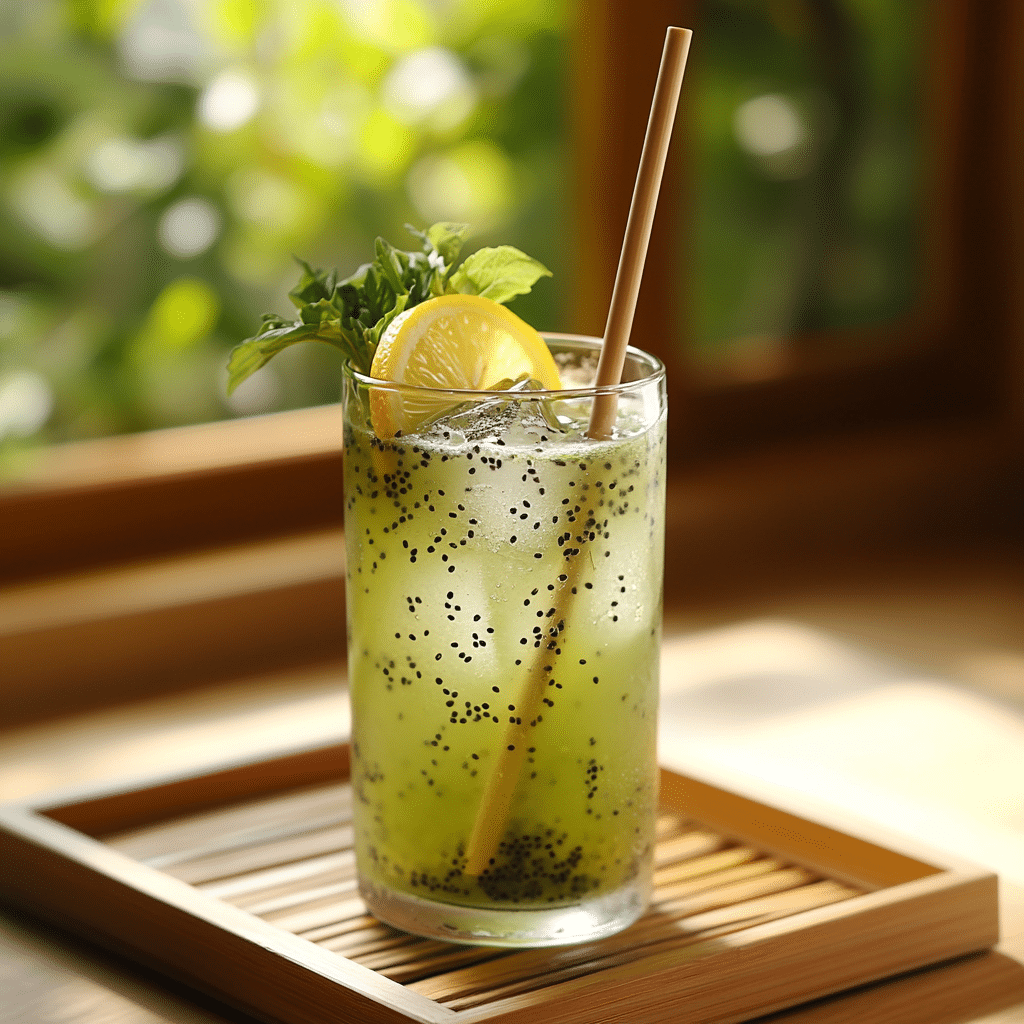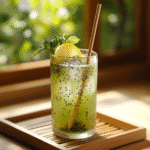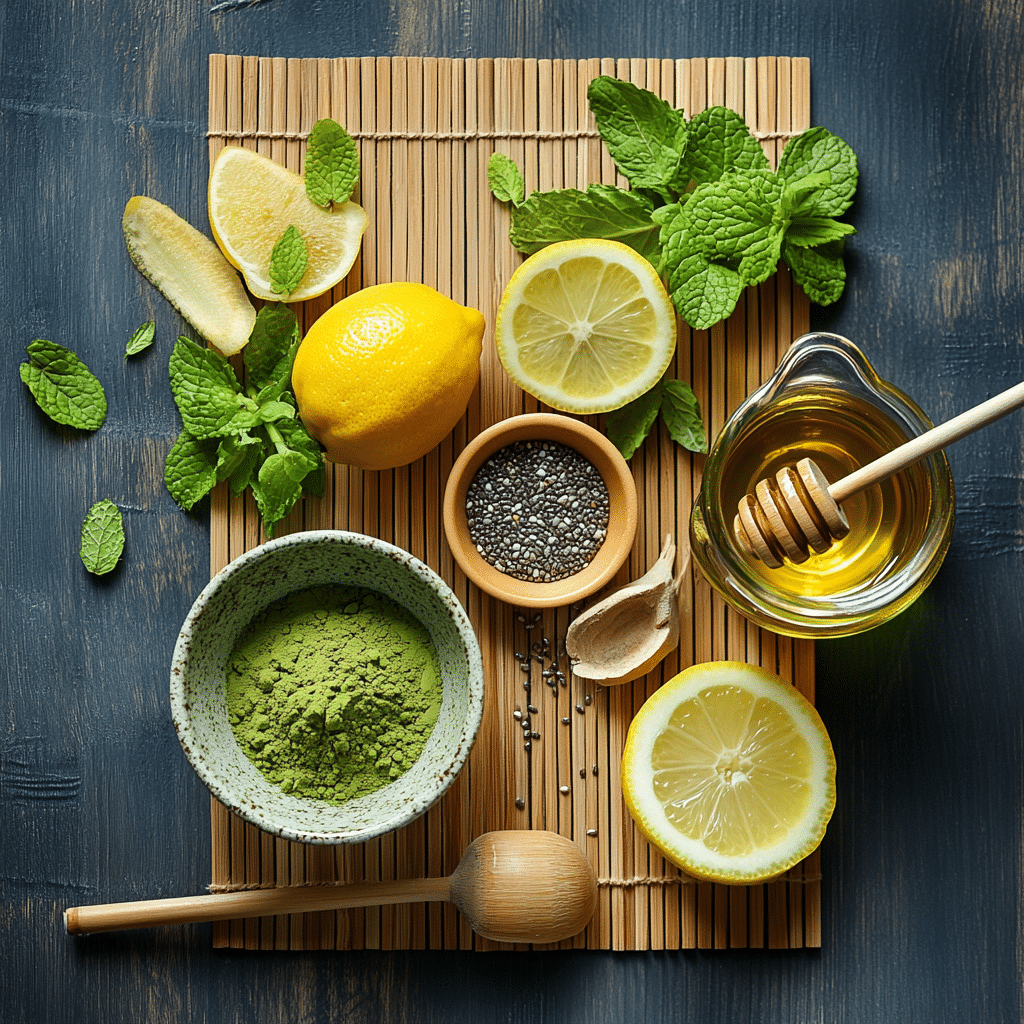Introduction

If you’re looking to elevate your wellness routine with a natural, culturally rooted ritual, the Japanese Mounjaro recipe might just be the perfect brew. Known for its detoxifying properties and calming essence, this drink blends centuries-old Japanese ingredients with modern adaptogenic principles to create a beverage that’s as soothing as it is health-boosting.
In this article, we’ll explore the origins of the Japanese Mounjaro tea, break down its unique ingredients, compare it to the Brazilian variation, and guide you through making it at home. Whether you’re here for the weight support, mental clarity, or just a refreshing natural tea, we’ve got you covered.
Discover great ideas like the Japanese Mounjaro Recipe and other revitalizing wellness drinks.
Print
Japanese Mounjaro Recipe – A Traditional Wellness Brew Redefined
- Total Time: 5 minutes
Description
A light, refreshing Japanese-inspired wellness drink made with ceremonial matcha, fresh yuzu or lemon, chia seeds, and a touch of honey. Perfect for weight-conscious lifestyles and those seeking a clean, metabolism-boosting beverage.
Ingredients
1 tsp matcha powder (ceremonial grade preferred)
1/2 yuzu or 2 slices fresh lemon
1 tsp chia seeds (optional)
1 tsp raw honey or zero-calorie sweetener (optional)
1 cup cold water or sparkling water
Fresh mint leaves (for garnish)
Ice cubes
Instructions
Whisk the matcha powder with a small amount of hot water until smooth and lump-free.
In a glass, add yuzu or lemon slices, honey (if using), and chia seeds (if using).
Fill the glass with ice cubes.
Pour the whisked matcha mixture over the ice.
Top up with cold water or sparkling water. Stir gently.
Garnish with fresh mint leaves and serve immediately.
Notes
Use ceremonial-grade matcha for best flavor and smoothness.
Adjust sweetness by adding more or less honey or sweetener.
For a creamy twist, substitute water with unsweetened almond milk.
Chia seeds add texture and extra fiber but are optional.
- Prep Time: 5 minutes
- Cook Time: 0 minutes
Keywords: Japanese Drink Wellness Drink Weight Loss Friendly Low Calorie Matcha Recipe Detox Drink
The Origins of the Japanese Mounjaro Recipe
The Cultural Significance of Mounjaro in Japan
The concept of Mounjaro in the Japanese context is deeply tied to holistic wellness and seasonal living. While the name might resonate globally due to its popularity in weight management communities, in Japan, Mounjaro reflects a time-honored ritual—a fusion of herbal medicine and tea ceremony practices aimed at restoring balance and inner peace.
Tea in Japanese culture has never been merely a beverage. It’s a spiritual practice, symbolizing mindfulness, purity, and harmony with nature. The Japanese Mounjaro recipe takes this a step further by incorporating herbs traditionally used in kampo (Japanese herbal medicine). Think mugwort (yomogi), yuzu peel, and green tea leaves—ingredients known for purifying the body and supporting digestion.
The Mounjaro drink is often consumed in the morning or after meals as a tonic. Traditionally, it’s offered during seasonal transitions to help the body detox and align with environmental changes. Families in Kyoto, for instance, may brew a variant during spring equinox festivals to cleanse and reset their bodies naturally.
Key Ingredients in a Japanese Mounjaro Recipe

Core Natural Elements Used (Matcha, Mugwort, Yuzu, etc.)
At the heart of the Japanese Mounjaro recipe lies a thoughtfully curated blend of traditional Japanese botanicals, chosen not only for their flavor but also for their therapeutic properties. Each ingredient contributes to the overall balance, making this tea more than just a drink—it’s a full sensory and wellness experience.
Let’s break down the core elements:
| Ingredient | Japanese Name | Function |
|---|---|---|
| Matcha | 抹茶 (まっちゃ) | Provides sustained energy and antioxidants |
| Mugwort | 蓬 (よもぎ) | Supports digestion, detox, and circulation |
| Yuzu Peel | 柚子 (ゆず) | Adds citrus aroma, boosts immunity |
| Shiso Leaf | 紫蘇 (しそ) | Anti-inflammatory, helps with allergies |
| Roasted Brown Rice | 玄米 (げんまい) | Adds nutty flavor, stabilizes blood sugar |
| Ginger Root | 生姜 (しょうが) | Aids in digestion, warms the body |
Matcha is perhaps the most recognizable ingredient, prized for its calm energy. It contains L-theanine, an amino acid that helps you stay focused without the jitters.
Mugwort, often used in traditional Japanese medicine, gives the brew an earthy tone and is believed to have liver-cleansing properties. It’s a staple in wellness circles for its detox effects and is even used in Japanese mochi desserts for its soothing flavor.
Yuzu peel, a fragrant citrus, adds brightness and aids in digestion. It also serves as a natural source of vitamin C, making the tea more immune-friendly, especially during the colder months.
Add-ins like shiso leaf, ginger, and even roasted brown rice (genmai) enhance flavor and offer layered benefits. Together, they turn the tea into a multi-functional elixir.
Modern Adaptogenic Blends and Their Benefits
Today’s wellness world is increasingly blending traditional practices with modern adaptogens. These are herbs and roots that help the body resist stressors of all kinds—physical, chemical, or biological.
Japanese Mounjaro teas are now seeing variations that include adaptogenic powerhouses like:
- Ashwagandha – reduces cortisol and stress
- Reishi mushroom – supports immunity and gut health
- Lion’s Mane – promotes brain clarity and cognitive strength
- Ginseng – enhances energy and stamina
Adding these into the Japanese Mounjaro base creates a hybrid drink that supports not only digestion and immunity but also mental performance and resilience.
The beauty of the modern Mounjaro blend lies in its versatility. You can keep it simple with matcha, mugwort, and yuzu, or elevate it with adaptogens to match your wellness goals.
Don’t miss our Millville Protein Pancake Mix Guide, an excellent breakfast to pair with your adaptogenic Mounjaro morning ritual.
Learn more about What Are the Ingredients in Brazilian Mounjaro? if you’re curious how other cultures craft their herbal drinks.
Step-by-Step Guide to Making Japanese Mounjaro Recipe at Home
Traditional Preparation Method (Steeping and Ceremony)
Creating the Japanese Mounjaro Recipe using traditional methods is more than just brewing tea—it’s a calming ritual rooted in centuries of Japanese wellness practices. When properly prepared, this Mounjaro wellness drink serves as both a flavorful detox beverage and a soothing moment of mindfulness.
You’ll Need:
- ½ tsp organic matcha powder
- 1 tsp dried mugwort (or mugwort tea bag)
- ½ tsp yuzu peel (dried or fresh zest)
- 1 thin slice of ginger (optional)
- 1 cup hot water (about 175°F)
- Tea bowl and bamboo whisk (chasen) or mesh strainer
Instructions:
- Warm Your Tools
Start the Japanese Mounjaro Recipe the traditional way by warming your bowl and whisk with hot water. This helps soften the matcha and ensures a smooth blend. - Blend Matcha and Mugwort
In the bowl, sift in your matcha powder and steep the mugwort using a mesh infuser. Mugwort is essential in the Japanese Mounjaro Recipe for its calming and detoxifying effect. - Add Yuzu and Ginger for Flavor Boost
Enhance your Japanese Mounjaro tea with natural citrus from yuzu peel and the anti-inflammatory warmth of fresh ginger. - Add Water and Whisk
Pour hot water over the blend. Whisk briskly in an “M” or “W” pattern with a bamboo whisk (chasen), or stir thoroughly with a spoon until smooth. - Steep and Sip Slowly
Allow the herbs to steep for 3–5 minutes to maximize flavor and health benefits. Strain if needed, and enjoy the Japanese detox tea slowly to absorb its calming energy.
This traditional Japanese Mounjaro recipe creates a rich green brew, earthy yet refreshing, and is ideal to enjoy during morning rituals or post-meal digestion.
Quick DIY Version with Store-Bought Ingredients
No time for a full ritual? This simplified version of the Japanese Mounjaro Recipe delivers similar benefits in a fraction of the time.
Quick Ingredients:
- 1 Japanese Mounjaro herbal blend tea bag
- 1 tsp unsweetened matcha latte mix
- 1 slice citrus (lemon or orange if yuzu is unavailable)
- ½ tsp honey or monk fruit (optional)
- 1 cup hot water
Fast Instructions:
- Steep the Japanese Mounjaro tea bag in hot water for 3–4 minutes.
- Stir in the matcha latte mix until dissolved.
- Add the citrus slice and sweetener, if using.
- Serve hot or chill over ice for a refreshing detox tea.
This modern take on the Japanese Mounjaro recipe is perfect for busy schedules, delivering natural energy and gentle cleansing in just minutes.
You don’t need a formal tea ceremony to enjoy the benefits of this powerful Japanese Mounjaro detox drink. Whether you stick to the traditional preparation or opt for a fast blend, the recipe remains a nutrient-packed, revitalizing wellness tea.
Health Benefits of Japanese Mounjaro Recipe
Detoxifying and Anti-Inflammatory Properties
One of the most praised aspects of the Japanese Mounjaro recipe is its ability to support natural detoxification. Thanks to its blend of traditional herbs like mugwort, matcha, and yuzu, this tea acts as a gentle cleanse for the body—flushing toxins, calming inflammation, and rejuvenating cellular function.
Let’s look at how each core component contributes to the detox process:
| Ingredient | Detox Effect |
|---|---|
| Mugwort | Supports liver and kidney function; reduces bloating |
| Matcha | High in EGCG (a powerful antioxidant); aids metabolism |
| Yuzu Peel | Enhances digestive enzyme activity and alkalizes the system |
| Ginger | Anti-inflammatory; promotes circulation and sweat detox |
| Roasted Rice | Provides fiber; stabilizes blood sugar post-detox |
Drinking the Japanese Mounjaro tea regularly may help:
- Cleanse the digestive tract
- Improve gut motility
- Reduce water retention
- Alleviate mild bloating or discomfort
The antioxidants found in this Mounjaro detox drink—especially from matcha—help neutralize free radicals, which can lead to fatigue, inflammation, and even premature aging if left unchecked.
If you’ve been feeling sluggish, puffy, or off-balance, incorporating the Japanese Mounjaro recipe into your daily routine may offer a noticeable improvement in both energy and clarity.
Mental Clarity, Focus, and Metabolism Support
In addition to physical detoxification, the Japanese Mounjaro recipe supports mental wellness and cognitive clarity. Unlike harsh stimulants or sugar-heavy drinks, this wellness tea provides calm, focused energy without crashes.
Here’s how it works:
- Matcha’s L-theanine promotes alpha brainwaves associated with relaxation and improved concentration.
- Mugwort has mild calming effects, helping reduce mental fog and nervous tension.
- Ginger and shiso stimulate circulation to the brain, enhancing oxygen flow.
- Yuzu lifts mood naturally with its citrus essential oils, shown to reduce cortisol levels.
Together, these ingredients create a brain-boosting formula ideal for:
- Morning productivity
- Afternoon slumps
- Pre-meditation or yoga sessions
- Reducing stress-related fatigue
From a metabolic standpoint, the Japanese Mounjaro tea gently elevates thermogenesis—your body’s fat-burning mechanism—without the jittery side effects of synthetic stimulants.
Regular use may:
- Increase resting metabolism
- Promote fat oxidation
- Stabilize blood sugar, curbing cravings
This makes the Japanese Mounjaro recipe an excellent tool for those aiming to support weight management naturally and holistically.
Natural Zepbound Recipe vs Mounjaro Tea – Which to Choose?
Natural Zepbound: Composition and Wellness Purpose
The term Zepbound has gained attention lately in wellness circles as a natural alternative for weight management, energy, and detox. While it might sound futuristic, the natural Zepbound recipe is based on a combination of herbal ingredients that activate metabolism, reduce cravings, and support insulin sensitivity.
Here’s a breakdown of a typical natural Zepbound recipe:
| Ingredient | Function |
|---|---|
| Green coffee extract | Supports metabolism and fat burning |
| Apple cider vinegar | Controls appetite and improves digestion |
| Lemon juice | Alkalizes and boosts vitamin C intake |
| Cayenne pepper | Thermogenic; stimulates circulation |
| Cinnamon | Balances blood sugar and reduces cravings |
| Ginger | Anti-inflammatory and gut-soothing |
This drink is usually consumed:
- Before meals to reduce appetite
- In the morning to boost metabolism
- After workouts to aid fat burning
It’s a bold, fiery drink that delivers results quickly. However, it may not be suitable for sensitive stomachs or those prone to acid reflux.
The natural Zepbound recipe is best for:
- People focused on weight loss
- Those needing quick metabolic stimulation
- Short-term detox programs
But what if you’re looking for a gentler, more sustainable option?
That’s where the Japanese Mounjaro recipe shines.
When to Use Mounjaro Tea vs Zepbound Based on Health Goals
Choosing between Japanese Mounjaro tea and the natural Zepbound recipe depends on your goals, body sensitivity, and lifestyle.
Let’s compare them side by side:
| Goal | Best Choice | Why |
|---|---|---|
| Gentle Daily Detox | Japanese Mounjaro Recipe | Supports gut health without harsh effects |
| Quick Fat Burn Boost | Natural Zepbound | Thermogenic ingredients stimulate metabolism |
| Mindfulness & Stress Relief | Japanese Mounjaro Tea | Matcha and mugwort help calm and focus the mind |
| Appetite Control | Zepbound Drink | ACV and cayenne are strong appetite suppressants |
| Sustainable Wellness Routine | Japanese Mounjaro Recipe | Easier to make part of a long-term habit |
| Short-Term Results | Zepbound | Delivers fast-acting effects, not ideal for daily use |
Japanese Mounjaro tea is more versatile, gentle, and suited for long-term health. It can be part of a mindful morning routine or a calming evening drink. It works on subtle systems like digestion, liver function, and mental clarity over time.
On the other hand, Zepbound is ideal for intensive short-term use. It’s sharp, effective, and results-driven—but may need to be cycled or used with cautio
FAQs about Japanese Mounjaro Recipe
What ingredients are in Mounjaro?
Mounjaro is a prescription medication containing tirzepatide, a dual GIP and GLP-1 receptor agonist used to treat type 2 diabetes and support weight loss. It does not contain food ingredients, as it is administered via injection and prescribed by a healthcare provider.
What is Brazilian Mounjaro?
“Brazilian Mounjaro” is a trending phrase often used to describe diet and meal plans inspired by Brazilian cuisine for those using Mounjaro. These recipes typically feature lean proteins, tropical vegetables, and low-carb ingredients that align with the weight loss goals supported by the medication.
What do I eat in a day on Mounjaro recipes?
A typical “day on Mounjaro recipes” includes low-carb, high-protein meals with lots of fiber. For example:
Breakfast: Scrambled eggs with avocado and spinach
Lunch: Grilled chicken salad with olive oil and lemon
Snack: Greek yogurt or a small handful of nuts
Dinner: Miso-glazed salmon with steamed bok choy and cauliflower rice
These meals help stabilize blood sugar and promote satiety.
What is the recipe for natural Zepbound?
While Zepbound is a prescription medication and not a food item, some refer to “natural Zepbound” as a lifestyle approach mimicking its effects. This includes:
A high-fiber, low-glycemic diet
Regular protein intake
Intermittent fasting or portion control
A sample natural recipe might include grilled tofu, mixed greens, edamame, and sesame-ginger dressing—designed to support metabolism and fullness naturally.
Conclusion
The Japanese Mounjaro recipe is more than just a trendy name—it’s a nourishing, flavor-packed dish that supports a healthy lifestyle, especially for those focusing on weight loss or managing blood sugar. Inspired by traditional Japanese ingredients and the wellness goals associated with Mounjaro users, this recipe offers a balanced way to enjoy your meals without compromising on taste or nutrition. Whether you’re meal prepping, eating clean, or simply exploring global flavors, the Japanese Mounjaro recipe makes a smart and satisfying addition to your weekly menu.
